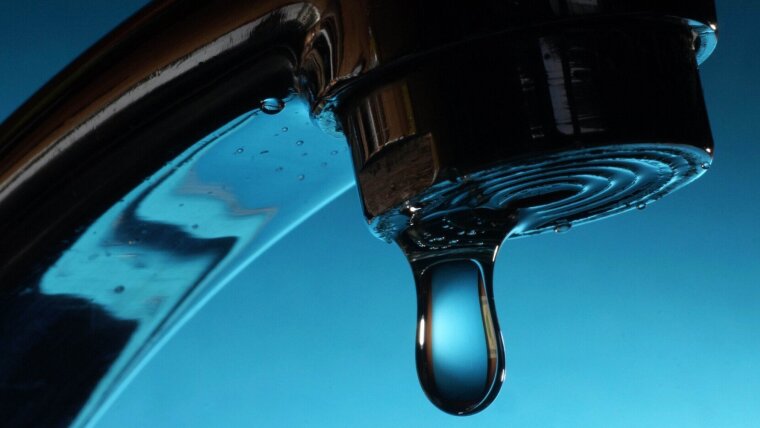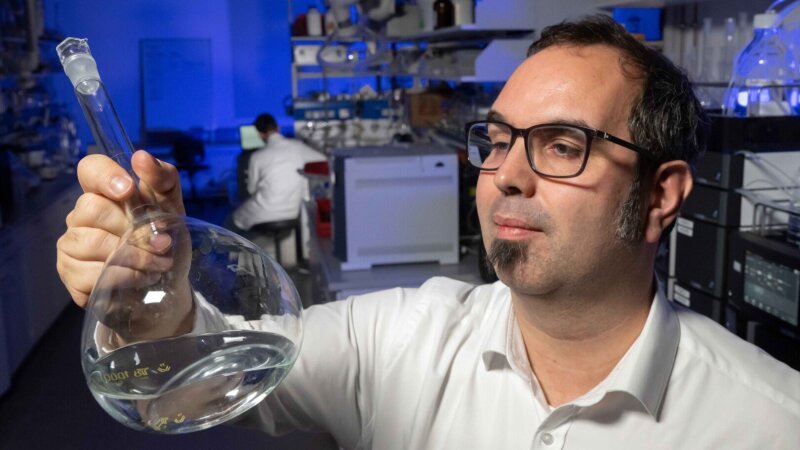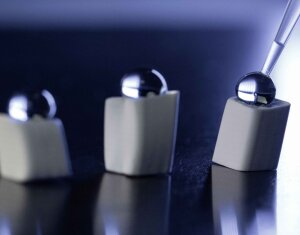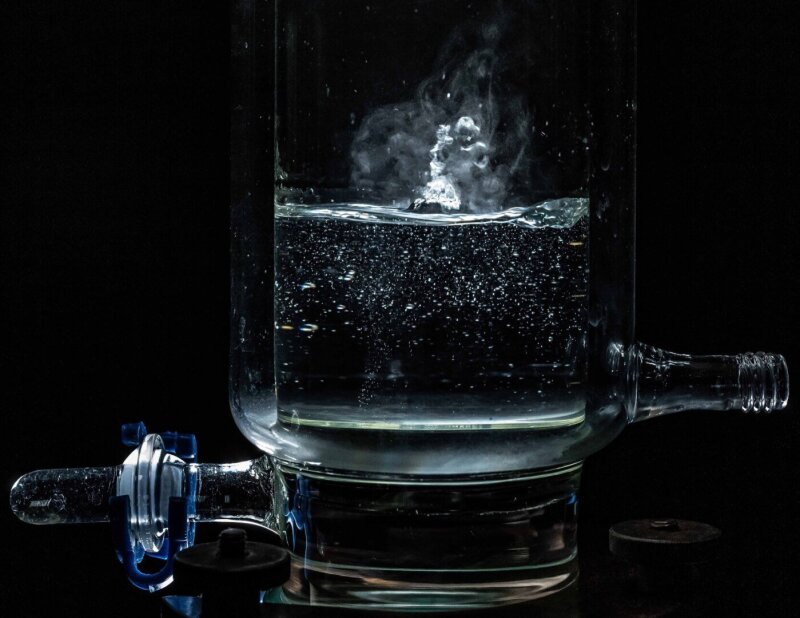
Clear, clean water, straight from the tap, available in every household. What is now taken for granted by many people really shouldn't be. After all, climate change, industry and agriculture – and not least our way of life – are putting our precious resource in danger. A team of chemists in the »ThWIC« water cluster are looking for new ways to detect pollutants in wastewater and reliably remove them to ensure the quality of our drinking water in the long term.
By Ute Schönfelder
In Germany alone, 27 million cubic metres of wastewater flow into the sewage system every day – from showers, washing machines and toilets. Around 96% of this is purified in sewage treatment plants. Various mechanical and biological cleaning processes are used to remove rubbish, gravel, sand, grease and oil, as well as dissolved organic substances, heavy metals, nitrates and phosphates. Around ten billion cubic metres are purified every year in approximately 10,000 sewage treatment plants across Germany before being returned to the natural water cycle.
However, the existing sewage treatment plants do not have a clean solution for all the substances and residues found in wastewater. In fact, the number and quantity of previously unconsidered pollutants in wastewater is constantly on the rise, as emphasized by Dr Patrick Bräutigam.
Drugs, pesticides, antibiotics: more and more pollutants in wastewater
»We've got a growing problem on our hands,« says the chemist from the Institute of Technical and Environmental Chemistry at the University of Jena and the Fraunhofer Institute for Ceramic Technologies and Systems. »In particular, the existing plants are often unable – or only marginally able – to remove drug residues, antibiotics, agricultural pesticides and industrial chemicals«.
The wastewater that passes through our sewage systems is often a real chemical cocktail. More and more (new) substances are being placed on the market around the world, and these can all end up in our wastewater. Around 100,000 different chemicals are currently approved in the EU. They are found in plastics, pharmaceuticals, skincare products, textiles and paper coatings. »Many of them occur in very low concentrations and cannot yet be effectively removed from wastewater,« says Dr Bräutigam. As the German population continues to age, for example, the amount of drug residues is steadily on the rise; according to the draft National Water Strategy presented by the German government, there will be a 70% rise in the consumption of medicines in Germany alone by the year 2045, placing an additional burden on the water cycle.
Some pollutants can be avoided or replaced with safe, biodegradable alternatives. Another forward-thinking approach to reducing water pollution is to recycle water in closed systems (e.g. in industry) to completely avoid wastewater. »But that's not possible for many chemicals, especially medication,« explains Dr Bräutigam. There is therefore an urgent need for new, effective methods of wastewater analysis.
And that is exactly where Dr Bräutigam and his teams at the University of Jena and the Fraunhofer Institute come into play. In future, they will also take this task on as part of the »ThWIC« water cluster, for which Bräutigam is a spokesperson. The environmental chemists at the University of Jena are researching a number of methods for treating water in such a way that all pollutants can be removed. »We're also developing ways of recording even the slightest pollution as continuously as possible,« continues Dr Bräutigam, »because only then can our sewage treatment plants react appropriately«. This also presumes that specifically adapted water treatment methods are required for different pollutants and the most suitable methods for degrading the detected chemicals can be predicted based on their chemical structure. The researchers are already working on this topic.
Pollutants removed by recyclable ceramic filters
There are various ways of removing micropollutants from wastewater. Some of the methods that are already in use attempt to remove micropollutants from the water by binding them to surfaces such as activated carbon. However, this does not work efficiently for all chemicals. »In addition, the activated carbon then has to be removed, transported and incinerated, or the substances themselves have to be removed from the activated carbon, which is complex and requires a lot of energy,« says Dr Bräutigam. That's why the chemist and his team are working on new materials that are highly effective in binding pollutants and clean themselves »at the push of a button«. »We're developing switchable ceramics for this purpose,« explains the chemist from the University of Jena.
The term »switchable« means that the ceramic surface properties can be changed by adjusting certain external parameters such as pH, light or temperature. In their original state, for example, the ceramics are water-repellent; if wastewater is passed through such an adsorber, the dissolved pollutants accumulate on its surface. The water leaves the adsorber in a purified state. The environmental parameters are then changed to convert the material into a water-absorbent state; the captured substances can be washed off again and disposed of as a concentrate. In the future, various textiles could also be coated with switchable materials and used as microorganism-resistant work clothing (e.g. in the medical field).
Dr Patrick Bräutigam is an environmental chemist and one of two spokespersons for the new »ThWIC« water cluster.
Image: Jens Meyer (University of Jena)Ceramic adsorbers adsorb and desorb water pollutants »at the push of a button«.
Image: Jens Meyer (University of Jena)Nano sieve filters
Ceramic materials are also used to create microscopically fine filters that can remove substances from water according to their molecular size and structure. This method can be used, for example, to separate oil-water emulsions. »We're currently working on a project with an industrial partner to recover metal processing lubricants used in the automotive industry,« says Patrick Bräutigam. The lubricants that stick to the metal surfaces are washed off with soap – and it is very difficult and expensive to dispose of the wastewater that accumulates during the car wash. »Our aim is to completely remove the lubricants from the water using filtration, so that the water can be reused on site and the factory is practically free of wastewater«.
Ultrasound and ozone for harmful chemicals
In addition to removing pollutants from water, they can also be rendered harmless by oxidation. »This is a bit like cold combustion,« explains Patrick Bräutigam. »During oxidation, the pollutants react with oxidizing agents and are converted into CO2 and water«. In order to set this process in motion, the chemists generate »hydroxyl radicals« in the wastewater. These are formed from the water itself without the need for any additional chemicals.
The researchers are testing various methods for creating hydroxyl radicals. One of the main areas of research covered by Dr Bräutigam's team revolves around »cavitation«. This is where bubbles are created in the water and then made to collapse. The bubbles are very small – only a few micrometres in diameter. When they collapse, however, extremely high temperatures develop locally – up to 5,000°C, like the sun – which produces the hydroxyl radicals needed for oxidation. The researchers initiate the cavitation process using high-power ultrasound or strong hydrodynamic flows – the efficiency of the procedure can be significantly enhanced by combining several methods at once.
The hydroxyl radicals required for the cold combustion process can also be generated by channelling ozone into the wastewater. This gas, which consists of atmospheric oxygen, is finely distributed throughout the wastewater in a pressurized environment. In addition to the hydroxyl radicals, the ozone itself also helps to oxidize pollutants and kill microorganisms.
Real-time monitoring with new sensors
In addition to various ways of purifying wastewater, Patrick Bräutigam and his colleagues are also developing new sensors that can be used to continuously determine wastewater quality in real time. This is particularly important in view of the new micropollutants, explains Dr Bräutigam. For example, drug residues can be detected in wastewater according to a distinct daily rhythm, because people tend to take their medication at the same time every day (e.g. in the morning or at night). »In an ideal world, sewage treatment plants would be able to actively respond to these fluctuations by adapting their purification processes according to the pollutant input«. However, this requires continuous monitoring - at present, that is only a vision for the future.
The ability to measure the specific concentrations of substances in water at specific times of the day would not only be an advantage for monitoring wastewater. Such methods could also be used to monitor the water quality of rivers and lakes with much more precision. This would significantly reduce the time needed to detect events such as the massive fish deaths that occurred in the River Oder last year, so that countermeasures can be taken in good time.
A reactor in which methods for oxidizing pollutants (e.g. ultrasound and ozonation) are tested on a laboratory scale.
Image: Jens Meyer (University of Jena)

